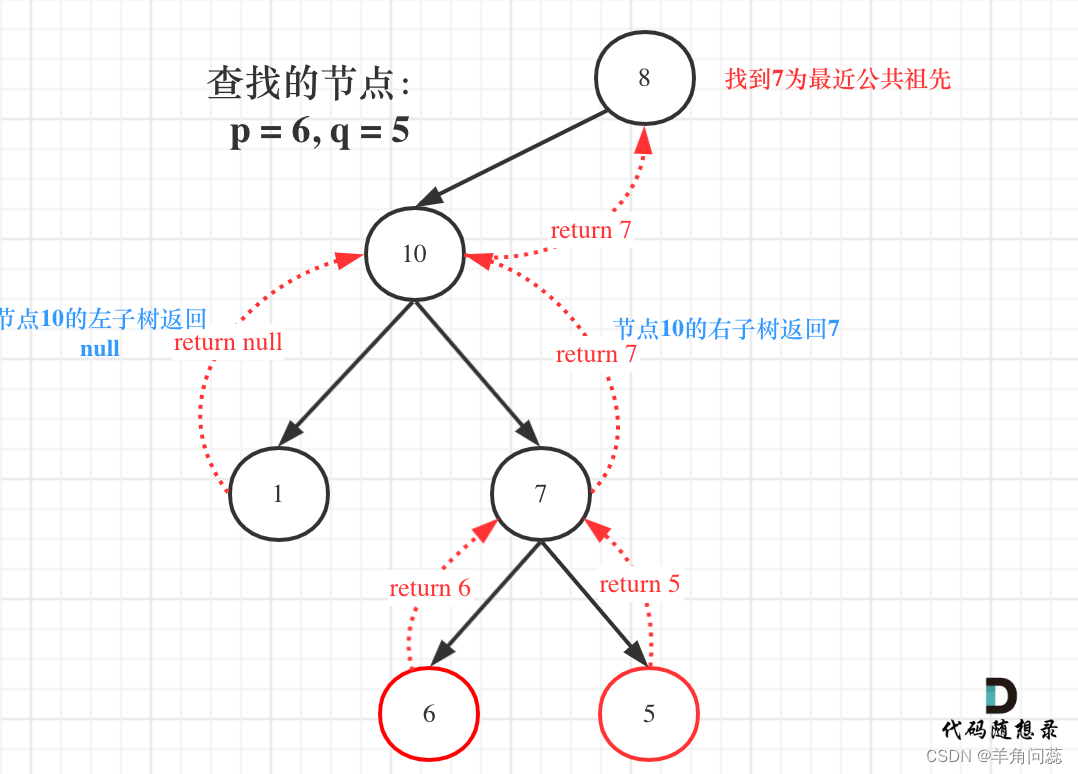题目:530.二叉搜索树的最小绝对差、501.二叉搜索树中的众数、236. 二叉树的最近公共祖先
参考链接:代码随想录
530.二叉搜索树的最小绝对差
思路:我一开始想到的方法是先生成中序序列,然后对相邻两项的差进行计算,取最小值,时间复杂度O(n)。
class Solution {
public:vector<int> inorder;void traverse(TreeNode* root){if(!root){return;}traverse(root->left);inorder.push_back(root->val);traverse(root->right);}int getMinimumDifference(TreeNode* root) {traverse(root);//节点范围从2开始int min=INT_MAX;for(int i=1;i<inorder.size();i++){if(inorder[i]-inorder[i-1]<min){min=inorder[i]-inorder[i-1];}}return min;}
};
然后想想能不能直接迭代,即每次遍历的时候记录前置节点,然后将差值对比。
class Solution {
public:TreeNode* pre=nullptr;int getMinimumDifference(TreeNode* root) {if(!root){return INT_MAX;//指示最小差值不存在}int left=getMinimumDifference(root->left);int min=left;//首先设置为左子树算出的结果if(pre&&root->val-pre->val<left){min=root->val-pre->val;}pre=root;//赋值前置节点,然后继续往后遍历int right=getMinimumDifference(root->right);if(right<min){//完成了左右中的比较min=right;}return min;}
};
实际上这样写代码很容易出错,真正写的时候就可以用额外生成的vector。标答把答案当做全局变量了,我们也建议单独写一个void遍历函数。
标答:
class Solution {
private:
int result = INT_MAX;
TreeNode* pre = NULL;
void traversal(TreeNode* cur) {if (cur == NULL) return;traversal(cur->left); // 左if (pre != NULL){ // 中result = min(result, cur->val - pre->val);}pre = cur; // 记录前一个traversal(cur->right); // 右
}
public:int getMinimumDifference(TreeNode* root) {traversal(root);return result;}
};
迭代法pass。
501.二叉搜索树中的众数
思路:简单的想法就是生成中序数组,然后使用哈希表统计元素出现个数,然后再输出。但是会有很多额外空间。其实这个方法对不是BST也可以,就是记录所有元素个数。时间复杂度O(n)。
class Solution {
public:unordered_map<int,int> mp;void traverse(TreeNode* root){if(!root){return;}traverse(root->left);mp[root->val]++;traverse(root->right);}vector<int> findMode(TreeNode* root) {vector<int> ans;int max=0;traverse(root);for(auto it:mp){if(it.second>max){max=it.second;}}for(auto it:mp){if(it.second==max){ans.push_back(it.first);}}return ans;}
};
标答将map进行了一个转换为vector后排序,我觉得没必要,这样复杂度反而变成O(nlogn)。
class Solution {
private:void searchBST(TreeNode* cur, unordered_map<int, int>& map) { // 前序遍历if (cur == NULL) return ;map[cur->val]++; // 统计元素频率searchBST(cur->left, map);searchBST(cur->right, map);return ;
}
bool static cmp (const pair<int, int>& a, const pair<int, int>& b) {return a.second > b.second;
}
public:vector<int> findMode(TreeNode* root) {unordered_map<int, int> map; // key:元素,value:出现频率vector<int> result;if (root == NULL) return result;searchBST(root, map);vector<pair<int, int>> vec(map.begin(), map.end());sort(vec.begin(), vec.end(), cmp); // 给频率排个序result.push_back(vec[0].first);for (int i = 1; i < vec.size(); i++) {// 取最高的放到result数组中if (vec[i].second == vec[0].second) result.push_back(vec[i].first);else break;}return result;}
};
考虑一下能不能利用BST的性质。即中序遍历有序,可以直接再遍历过程中操作,和上一题一样,不需要使用额外空间,使用pre指针,在对每个节点遍历的时候记录其出现次数,遍历一遍即可记录最大次数,然后第二次遍历,对最大次数的节点进行输出即为结果。看完解析发现可以通过一些简单的代码操作只进行一次遍历,即每次进行次数更新的时候,将结果clear()即可。可以看到对BST,利用其有序性,双指针有很大用处。
class Solution {
public:TreeNode* pre=nullptr;int count=0;int maxCount=INT_MIN;void traverse(TreeNode* root,vector<int>& ans){if(!root){return;}traverse(root->left,ans);if(!pre||root->val!=pre->val){//第一个元素,指针为空,或者当前和pre不同count=1;}else{//两个相邻相等count++;}pre=root;//此时已经完成count计数,然后和max比较if(count>maxCount){ans.clear();//更新,之前全部删掉maxCount=count;ans.push_back(root->val);}else if(count==maxCount){//等于也要增加结果ans.push_back(root->val);}traverse(root->right,ans);}vector<int> findMode(TreeNode* root) {vector<int> ans;traverse(root,ans);return ans;}
};
迭代法pass
236. 二叉树的最近公共祖先
思路:由于二叉树无法自底向上搜索,肯定需要回溯法。给定pq,需要分情况讨论。首先是简单情况,一个节点的两个孩子分别为p和q,这时候直接返回p或者q,如果为空,则返回空。我们需要把返回值一层一层往上传递,对根节点root,如果左右孩子都为空,则返回空,如果两个节点仅有一个找到了 ,则直接把这一个往上传递,如果两个都不为空,那么这个节点就是最近公共祖先,直接往上返回,最后的返回结果会传递到根节点。本题需要先处理左右孩子,最后确定根节点的返回值,为后序遍历。时间复杂度O(n)。

class Solution {
public:TreeNode* lowestCommonAncestor(TreeNode* root, TreeNode* p, TreeNode* q) {if(!root||root==p||root==q){//终止条件,表示找到return root;}TreeNode* left=lowestCommonAncestor(root->left,p,q);TreeNode* right=lowestCommonAncestor(root->right,p,q);if(!left&&!right){//处理完左右后四种情况return nullptr;}else if(left&&!right){return left;}else if(!left&&right){return right;}else{return root;}}
};
没有迭代法。






——之固件下载)
XML基础)
)

![[bing]“gang调度 Kubernetes的并发控制和一致性机制“论点的对应的源码分析](http://pic.xiahunao.cn/[bing]“gang调度 Kubernetes的并发控制和一致性机制“论点的对应的源码分析)



,等同于实现flink的Credit-based反压原理)
)



)